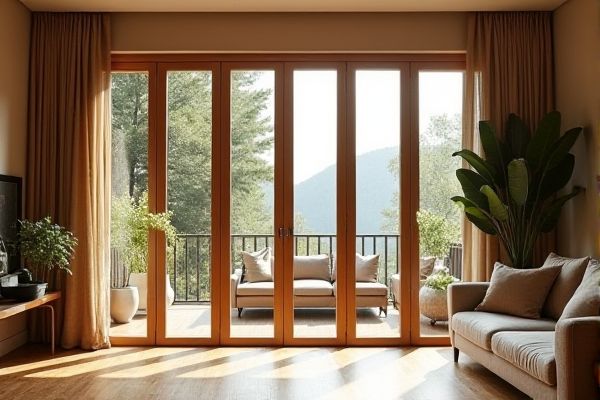
Bi-fold screens offer a compact and elegant solution ideal for small spaces, while triple-panel screens provide greater coverage and more versatile design options for dividing larger areas. Explore the rest of the article to discover which choice suits your needs and enhances your space perfectly.
Table of Comparison
| Feature | Bi-Fold Screen | Triple-Panel Screen |
|---|---|---|
| Number of Panels | 2 panels | 3 panels |
| Space Efficiency | Moderate, folds in half | High, folds into thirds |
| Portability | Compact, easy to carry | Compact but slightly bulkier |
| Setup Time | Quick, simple folding | Moderate, more panels to unfold |
| Screen Size | Smaller or medium size | Generally larger display area |
| Use Case | Small spaces, quick tasks | Multitasking, extended views |
| Cost | Lower price range | Higher price range |
Introduction to Folding Screen Technologies
Folding screen technologies have revolutionized display versatility by enabling flexible and compact designs such as bi-fold and triple-panel screens. Bi-fold screens feature two interconnected panels that fold inward, offering a balance between portability and expanded viewing area. Triple-panel screens incorporate three linked panels, providing a larger, more immersive display while maintaining foldability for enhanced multitasking and space efficiency.
What is a Bi-Fold Screen?
A bi-fold screen consists of two panels connected by hinges, allowing it to fold in half for compact storage or expanded use. This design offers flexibility and space-saving benefits, making it ideal for room dividers, privacy screens, or decorative accents. Your choice of a bi-fold screen provides a simple yet versatile option compared to the larger and more complex triple-panel screens.
What is a Triple-Panel Screen?
A triple-panel screen consists of three connected display sections that fold or unfold to expand the viewing area, providing enhanced multitasking and immersive experiences compared to traditional single or bi-fold screens. Often used in high-end monitors and portable devices, triple-panel screens deliver a wider field of view with seamless content transitions across the panels. This setup benefits professionals requiring extensive screen real estate, such as video editors and designers, by enabling simultaneous access to multiple applications without window overlap.
Design and Aesthetic Differences
Bi-fold screens typically feature two large panels that fold neatly to save space, offering a minimalist and sleek appearance ideal for modern interiors. Triple-panel screens consist of three connected panels, providing a more dynamic and segmented design that can serve both functional privacy and decorative purposes. Your choice depends on whether you prefer the simplicity and compactness of a bi-fold screen or the versatile, artistic appeal of a triple-panel arrangement.
Display Size and Aspect Ratio Comparison
Bi-fold screens typically offer a larger continuous display area by folding a single panel, resulting in seamless visual content with minimal bezels and an aspect ratio close to 16:9 or wider, enhancing immersive viewing experiences. Triple-panel screens consist of three separate panels combined to form an extended workspace, often with adjustable configurations, but may introduce visible bezels that affect the uninterrupted display size and create variable aspect ratios depending on panel orientation. For your setup, bi-fold screens maximize uninterrupted display size with consistent aspect ratio, while triple-panel screens provide versatile workspace customization at the expense of bezel interruptions and less uniform aspect ratios.
Durability and Hinge Mechanism Analysis
Bi-fold screens feature a single hinge mechanism that often utilizes reinforced metal for enhanced durability, ensuring smooth folds and resistance to wear over time. In contrast, triple-panel screens incorporate two hinges, which may introduce increased complexity and potential points of failure, but high-quality engineering can mitigate these risks with robust hinge designs and materials. Your choice should consider the frequency of use and the hinge quality, as durability heavily depends on the construction and materials used in both bi-fold and triple-panel screens.
Portability and User Convenience
Bi-fold screens offer superior portability due to their compact design, folding easily to fit into smaller bags for on-the-go use. Triple-panel screens, while providing expanded display space, are bulkier and less convenient to carry, making them ideal for stationary setups. Your choice depends on whether you prioritize easy transport or increased multitasking space.
Performance and Multitasking Capabilities
Bi-fold screens offer enhanced performance with a seamless large display ideal for immersive multitasking and running multiple applications side-by-side without lag. Triple-panel screens provide superior multitasking capabilities by allowing users to organize different workspaces across three separate screens, improving workflow efficiency for complex tasks. Both setups leverage advanced graphics processing units (GPUs) and multi-window management to optimize productivity in professional and creative environments.
Price and Market Availability
Bi-fold screens generally offer a more affordable option, with prices ranging from $100 to $300, and they are widely available in retail and online stores. Triple-panel screens tend to be more expensive, often exceeding $400, due to their larger size and complex design, and have a narrower market presence primarily in specialized furniture and home decor shops. When deciding, your choice will depend on budget constraints and the availability of the product in your preferred market.
Future Trends in Foldable Screen Devices
Future trends in foldable screen devices highlight significant advancements in bi-fold and triple-panel screens, showcasing increased durability, seamless folding mechanisms, and enhanced multitasking capabilities. Bi-fold screens continue to dominate due to their compact design and improved battery efficiency, while triple-panel screens are gaining traction by offering expansive display areas ideal for immersive media consumption and productivity. Your choice will depend on whether you prioritize portability with bi-fold or enhanced functionality and screen real estate with triple-panel technology.
 homyna.com
homyna.com